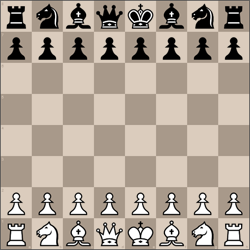 |

 Chessically Yours 16 Mar 1962, Fri The News (Paterson, New Jersey) Newspapers.com Chessically Yours 16 Mar 1962, Fri The News (Paterson, New Jersey) Newspapers.com |
The News, Paterson, New Jersey, Friday, March 16, 1962
Chessically Yours by Henry Overeem
An intense and friendly rivalry was automatically created between Robin Ault, of Cranford and Peter Irwin, of Summit, in the Junior age chess tournaments. Peter, younger than Robin, is another young New Jersey chess product with tremendous potential. He soon emerged as a consistant if unsuccessful challenger to Robin's domination of Junior chess events. His destiny became his frustration, yet even in the shadow of defeat he won much glory and renown.
In the New Jersey Junior championship tournament of 1959 Robin played one of his wild and fantastic games, a King Bishops gambit, with which Peter could not cope. This game must have been played after Robin had begun the translation of “300 Chess Games” for shades of Tarrasch are clearly evident. Of the game itself Robin later wrote, “My most enjoyable victory against my favorite victim.”
Robin Ault (white) vs. Peter Irwin (black)
King's Gambit Accepted: Bishop's Gambit, Cozio Variation
Notes by Robin Ault: Q-R3 is more usual for black's 5th and better than the text. Black's 6th is weakening, P-KN4, but QxP would have allowed 7. BxPch. On 13…Q-B5ch black hopes to relieve some of the threats by exchanging queens; but white's minor pieces cooperate beautifully, aided by Black's suicidal impulses.
The second game is from the 1961-62 Columbia College Championship. This is the era of stodginess, the lack of fire and daring when the effect of Tarrasch has worn off. Here stands Robin exposed, now let's see how stodgy this game really is.
Jerome Lee Finkelstein (white) vs. Robin Ault (black)
Indian Defense: Budapest Defense, Adler Variation
6. A questionable idea.
8. And another.
9. Q-B2 was preferable to prevent black's next move.
11. There is no question about this idea—it is definitely bad.
12. White dare not castle, either immediately or after 13. BxN, PxB. In view of this, it might have been better for white to renounce castling on move 12, with King-B1. Even here the move would not be so bad. However, white indescreetly weakens his king-side.
15. Much better than Q-R3, which fits in with black's intention of R-K. Black must prevent the white queen from leaving the first rank, else white could castle queen-side and relieve the pressure.
17. Not 17. PxB, mate in 2. After the text the threat is PxB. 17. R-KN fails against RxPch. But, 17. R-KN would get white off rather cheaply. However, with the text move, white clearly did not see black's pretty and ingenious reply.
19. Born of desperation.
21. Resigns.
A pretty stodgy game. I wonder where I can buy a book on “How to Play Stodgy Chess.”























